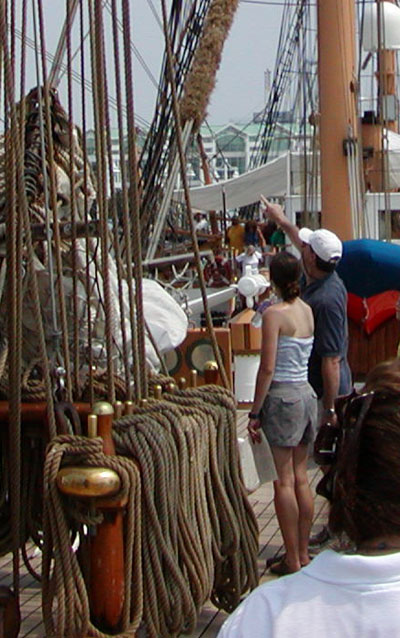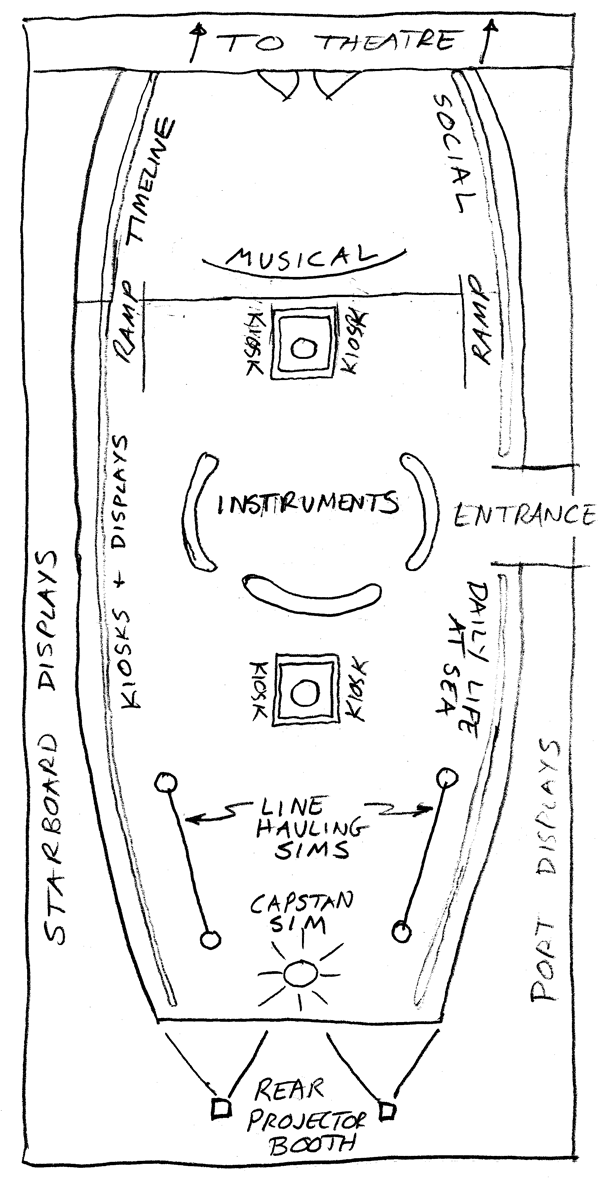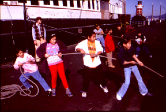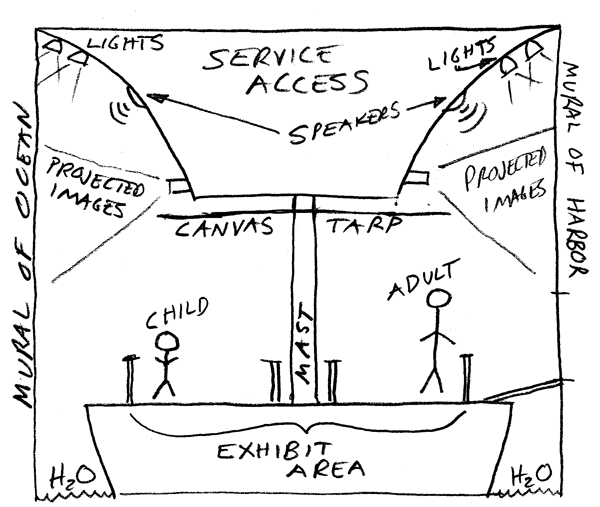EDTEC 671: Learning Environment Design
Informal Learning Exhibit Objects
The New London Sea Chantey Museum
Informal Learning Environment ~ Specifications
(Download: 444kb .doc)
Exhibit/Display Design—Part 2: Materials
 The sea chantey exhibit will center around a simulated schooner deck. The visitors will “come aboard” at the waist (middle) area of the ship. To the left will be an activity area at the bow (front) of the ship. Historical displays will be at the stern (back) area of the ship. Authentic lines and rigging will surround the periphery of the exhibit, which will be backset from walls decorated with ocean and harbor scenes. The simulated masts will serve as supports for exhibit material and hiding places for machinery and technology. The overhead (ceiling) area will be painted like the sky and illuminated to give the illusion of a larger space under the canvas of the waist.
The sea chantey exhibit will center around a simulated schooner deck. The visitors will “come aboard” at the waist (middle) area of the ship. To the left will be an activity area at the bow (front) of the ship. Historical displays will be at the stern (back) area of the ship. Authentic lines and rigging will surround the periphery of the exhibit, which will be backset from walls decorated with ocean and harbor scenes. The simulated masts will serve as supports for exhibit material and hiding places for machinery and technology. The overhead (ceiling) area will be painted like the sky and illuminated to give the illusion of a larger space under the canvas of the waist.
Deck (floor) material will be smooth finished wood planking with some areas accented by brown, tan, and dark grey outdoor carpet.

Rigging will be the authentic dimensions and coloring of a real schooner, but ruggedized for public exposure, and limited in scope to provide “atmosphere” only (and keep kids from climbing on it). Rails will be authentic wooden reproductions and shellacked. “Overboard” areas will be simulated water, filled with blue foam blocks in case someone falls over the side. All deck fittings will be authentic to a working schooner from the days of sail.
Benches will be wood planking covered with leather pads. The central hub area will allow people to gather, relax, interact with other participants, and generally live the life of a sailor – if only for a few minutes.
Projection screens will resemble ship’s sails when not in use. Sail material will have rigging points so certain presentations can be modified if necessary.
Simulated halyard will be smooth nylon or sisal replicas, to keep visitors from going home with twisted hemp splinters.
Display cases will be presented as views to the deck below (even though the deck does not exist). One just forward of the mizzenmast will show the galley, the other just forward of the mainmast will show the sailor’s berthing area. The ledges of these display cases will contain artifacts with small explanatory signs
Lesson Plan & Learning Materials—Part 2: Activities
Bow
 This area will be reserved for high energy activities. In the bow area is the capstan. A simulated anchor chain comes from the hawse pipe, around the capstan, and goes below into the chain locker. One of the activities will be “getting the ship underway”, which starts by weighing the anchor. Led by a crewmember, visitors will man the capstan and participate in a capstan chantey to raise the anchor. A simulated anchor will be projected just over the port rail, so participants can see the fruits of their labors. Also in the bow are a pair of halyard lines. Participants will work as a team to raise a sail, or against a second team to see which can raise the sail faster (or in better time with the chanteyman). Participants will see a video projection of a staysail so they can judge their progress during the haul. If no visitors wish to participate, the exhibit staff will man the line and haul away to demonstrate how a chantey is used to spur collective effort.
This area will be reserved for high energy activities. In the bow area is the capstan. A simulated anchor chain comes from the hawse pipe, around the capstan, and goes below into the chain locker. One of the activities will be “getting the ship underway”, which starts by weighing the anchor. Led by a crewmember, visitors will man the capstan and participate in a capstan chantey to raise the anchor. A simulated anchor will be projected just over the port rail, so participants can see the fruits of their labors. Also in the bow are a pair of halyard lines. Participants will work as a team to raise a sail, or against a second team to see which can raise the sail faster (or in better time with the chanteyman). Participants will see a video projection of a staysail so they can judge their progress during the haul. If no visitors wish to participate, the exhibit staff will man the line and haul away to demonstrate how a chantey is used to spur collective effort.
Waist
 The middle of the ship will include interactive exhibits and medium energy activities. Spill over from this section will take people to either the high energy bow or low energy stern. Parabolic speakers will concentrate musical presentations to areas along both outboard rails. The central area will mainly contain interactive computer simulations and kiosks. This area will also serve as the “lounge” or café area, where visitors can mix and mingle, practice their chanteys, and enjoy some grog or other beverage. Hourly chantey sessions will be recorded and posted to the internet. Visitors will be given the code for their group’s recording so they can download their performance from home. Alternately, they’ll be able to purchase a CD with their performance and a representative set of other “professional” chanteys. Visitors will be able to handle real musical instruments used by chanteymen, such as spoons, cups, concertinas, and whistles.
The middle of the ship will include interactive exhibits and medium energy activities. Spill over from this section will take people to either the high energy bow or low energy stern. Parabolic speakers will concentrate musical presentations to areas along both outboard rails. The central area will mainly contain interactive computer simulations and kiosks. This area will also serve as the “lounge” or café area, where visitors can mix and mingle, practice their chanteys, and enjoy some grog or other beverage. Hourly chantey sessions will be recorded and posted to the internet. Visitors will be given the code for their group’s recording so they can download their performance from home. Alternately, they’ll be able to purchase a CD with their performance and a representative set of other “professional” chanteys. Visitors will be able to handle real musical instruments used by chanteymen, such as spoons, cups, concertinas, and whistles.
Stern
 The back of the ship will contain the historical “library” displays, social exploration, and artifacts from the days of sail. Laminated books containing musical transcriptions, replica tools of square-rig sailors, and authentic costumes will all reside here. This area will be the most self-led area of the exhibit, but one roving staff member will be available to call attention to related material. All three “tracks” will be represented in a different area: History, Music, and Social. The Stern area will also serve as the lobby for the theatre, and can be used for reception or meeting space after hours.
The back of the ship will contain the historical “library” displays, social exploration, and artifacts from the days of sail. Laminated books containing musical transcriptions, replica tools of square-rig sailors, and authentic costumes will all reside here. This area will be the most self-led area of the exhibit, but one roving staff member will be available to call attention to related material. All three “tracks” will be represented in a different area: History, Music, and Social. The Stern area will also serve as the lobby for the theatre, and can be used for reception or meeting space after hours.
Additional Information
http://en.wikipedia.org/wiki/New_London%2C_Connecticut
http://en.wikipedia.org/wiki/Sea_shanty